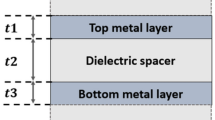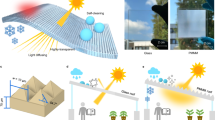Abstract
The possibility of using multilayer structures based on transparent polymeric films with conducting coatings as heaters for removing snow cover is discussed. It is established that the heaters with cellular polycarbonate slabs 4 mm in thickness are more efficient. The specific capacity spent by these heaters on warming by 20°C is 300 W/m2; for comparison, the capacity of the heaters pasted to the insulating glass unit surface is 420 W/m2.





Similar content being viewed by others
REFERENCES
N. L. Gavrilov-Kremichev and I. L. Nikolaeva, System Structures for Windows, Doors and Front Designs: Reference Book (Modern Building Designs, Moscow, 2007).
L. V. Marshaniya, M. A. Nefedova, and S. D. Pestich, “Snow loads on domed surfaces. An example and review of this problem in different sources,” Academy, No. 6, 8–11 (2019).
W. Jiang, Y. Huang, and A. Sha, “A review of eco-friendly functional road materials,” Constr. Build. Mater. 191, 1082–1092 (2018).
L. I. Gulak and N. V. Shatalova, “Maintenance of the translucent roof in winter,” Inzh. Sist. Sooruzh., No. 4, 38–42 (2015).
V. A. Bogatov, A. G. Krynin, O. V. Popkov, and Yu. A. Khokhlov, “The effect of biaxial deformation on the properties of a transparent electrically conductive coating deposited on a PET film by reactive magnetron sputtering,” Tr. VIAM, No. 1 (2016). https://doi.org/10.18588/2307-6046-2016-0-1-42-49
T. C. Gorjanca, D. Leonga, C. Py, and D. Rotha, “Room temperature deposition of ITO using r.f. magnetron sputtering,” Thin Solid Films 413, 181–185 (2002).
Yu. A. Khokhlov, V. A. Bogatov, N. M. Berezin, and A. G. Krynin, “Reactive magnetron deposition of an ITO coating on a polymer film using a sectioned gas supply system,” Tr. VIAM, No. 5 (2015). https://doi.org/10.18577/2307-6046-2015-0-5-7-7
E. N. Kablov, “New generation materials as the basis for innovation, technological leadership, and national security of Russia,” Intell. Tekhnol., No. 2, 16–21 (2016).
E. N. Kablov, “What to make the future of? New generation materials and technologies for their creation and processing as the basis of innovations,” Kryl’ya Rodiny, No. 5, 8–18 (2016).
E. N. Kablov, L. V. Semenova, V. A. Bogatov, I. V. Mekalina, A. G. Krynin, and M. K. Aizatulina, “New electrically heated and bird-strike-resistant polymer glazing for aircraft,” Int. Polym. Sci. Technol. 45 (5), 231–236 (2018).
E. N. Kablov, N. O. Yakovlev, I. V. Mekalina, and G. M. Kharitonov, “The relaxation behavior of polymer glass based on polymethylmethacrylate and its consideration in the strength calculation of aircraft glazing,” Polym. Sci., Ser. D 10 (2), 200–205 (2017).
A. I. Kuz’michev, Magnetron Spray Systems. Introduction to the Physics and Technology of Magnetron Sputtering (Avers, Kiev, 2008), Book 1 [in Russian].
S. H. Jeong, J. W. Lee, S. B. Lee, and J. H. Boo, “Deposition of aluminum-doped zincoxide films by RF magnetron sputtering and study of their structural, electrical and optical properties,” Thin Solid Films 435, 78–82 (2003).
Kan Zhang, M. Wen, G. Cheng, X. Li, Q. N. Meng, J. S. Lian, and W. T. Zheng, “Reactive magnetron sputtering deposition and characterization of niobium carbide films,” Vacuum 99, 233–241 (2014).
K. Ellmer and T. Welzel, “Reactive magnetron sputtering of transparent conductive oxide thin films: Role of energetic particle (ion) bombardment,” J. Mater. Res. 27 (05), 765–779 (2012).
V. M. Elinson, P. A. Shchur, D. V. Kirillov, A. N. Lyamin, and O. A. Silnitskaya, “Study of the mechanical characteristics of single-layer and multilayer nanostructures based on carbon and fluorocarbon coatings,” J. Surf. Invest.: X-Ray Synchrotron Neutron Tech. 12 (2), 342–345 (2018).
E. N. Kablov, “Innovations of the All-Russian Institute of Aviation Materials (VIAM) as part of implementing the Strategic Directions of Development of Materials and Technologies of Their Processing for the Period up to 2030,” Aviats. Mater. Tekhnol., No. 1, 3–33 (2015). https://doi.org/10.18577/2071-9140-2015-0-1-3-33
A. A. Mel’nikov and P. A. Shchur, “Transparent electroconductive antireflection coatings based on ITO, SiO2, and TiO2,” Tr. VIAM, No. 8, 56–66 (2019). https://doi.org/10.18577/2307-6046-2019-0-8-56-66
Funding
This work was written as part of the implementation of integrated research project 15 “Nanosize and Amorphous Coatings and Materials” (“Strategic Areas of Designing Materials and Their Processing Technologies up until 2030” [18].)
Author information
Authors and Affiliations
Corresponding author
Ethics declarations
The authors declare that they have no conflicts of interest.
Additional information
Translated by S. Kuznetsov
Rights and permissions
About this article
Cite this article
Mel’nikov, A.A., Shchur, P.A., Solov’yanchik, L.V. et al. Using Transparent Conducting Coatings for Warming Transparent Roofs. Polym. Sci. Ser. D 14, 93–96 (2021). https://doi.org/10.1134/S1995421221010172
Received:
Revised:
Accepted:
Published:
Issue Date:
DOI: https://doi.org/10.1134/S1995421221010172




